2014 FIAT 500L LIVING Warning lights
[x] Cancel search: Warning lightsPage 255 of 420
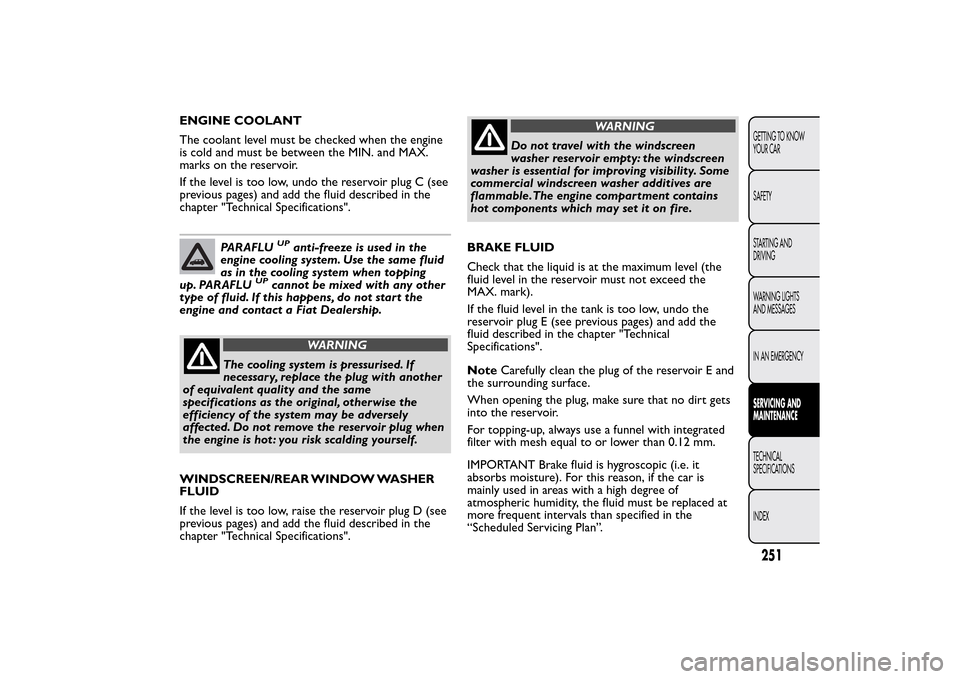
ENGINE COOLANT
The coolant level must be checked when the engine
is cold and must be between the MIN. and MAX.
marks on the reservoir.
If the level is too low, undo the reservoir plug C (see
previous pages) and add the fluid described in the
chapter "Technical Specifications".
PARAFLU
UP
anti-freeze is used in the
engine cooling system. Use the same fluid
as in the cooling system when topping
up. PARAFLU
UP
cannot be mixed with any other
type of fluid. If this happens, do not start the
engine and contact a Fiat Dealership.
WARNING
The cooling system is pressurised. If
necessary, replace the plug with another
of equivalent quality and the same
specifications as the original, otherwise the
efficiency of the system may be adversely
affected. Do not remove the reservoir plug when
the engine is hot : you risk scalding yourself.
WINDSCREEN/REAR WINDOW WASHER
FLUID
If the level is too low, raise the reservoir plug D (see
previous pages) and add the fluid described in the
chapter "Technical Specifications".
WARNING
Do not travel with the windscreen
washer reservoir empty: the windscreen
washer is essential for improving visibility. Some
commercial windscreen washer additives are
flammable.The engine compartment contains
hot components which may set it on fire.
BRAKE FLUID
Check that the liquid is at the maximum level (the
fluid level in the reservoir must not exceed the
MAX. mark).
If the fluid level in the tank is too low, undo the
reservoir plug E (see previous pages) and add the
fluid described in the chapter "Technical
Specifications".
NoteCarefully clean the plug of the reservoir E and
the surrounding surface.
When opening the plug, make sure that no dirt gets
into the reservoir.
For topping-up, always use a funnel with integrated
filter with mesh equal to or lower than 0.12 mm.
IMPORTANT Brake fluid is hygroscopic (i.e. it
absorbs moisture). For this reason, if the car is
mainly used in areas with a high degree of
atmospheric humidity, the fluid must be replaced at
more frequent intervals than specified in the
“Scheduled Servicing Plan”.
251GETTING TO KNOW
YOUR CAR
SAFETY
STARTING AND
DRIVING
WARNING LIGHTS
AND MESSAGES
IN AN EMERGENCYSERVICING AND
MAINTENANCETECHNICAL
SPECIFICATIONS
INDEX
Page 256 of 420

Prevent brake fluid, which is highly
corrosive, from coming into contact with
painted parts. Should it happen,
immediately wash with water.
WARNING
Brake fluid is poisonous and highly
corrosive. In the event of accidental
contact , immediately wash the affected parts
with water and neutral soap.Then rinse
thoroughly. Call a doctor immediately if
swallowed.
WARNING
The symbol
on the container indicates
a synthetic brake fluid, distinguishing it
from the mineral type. Using a mineral-type
fluid will damage the special rubber seals of the
braking system beyond repair.
AIR CLEANER/POLLEN
FILTER/DIESEL FILTERFor filter replacement, contact a Fiat Dealership.
252GETTING TO KNOW
YOUR CAR
SAFETY
STARTING AND
DRIVING
WARNING LIGHTS
AND MESSAGES
IN AN EMERGENCYSERVICING AND
MAINTENANCE
TECHNICAL
SPECIFICATIONS
INDEX
Page 257 of 420
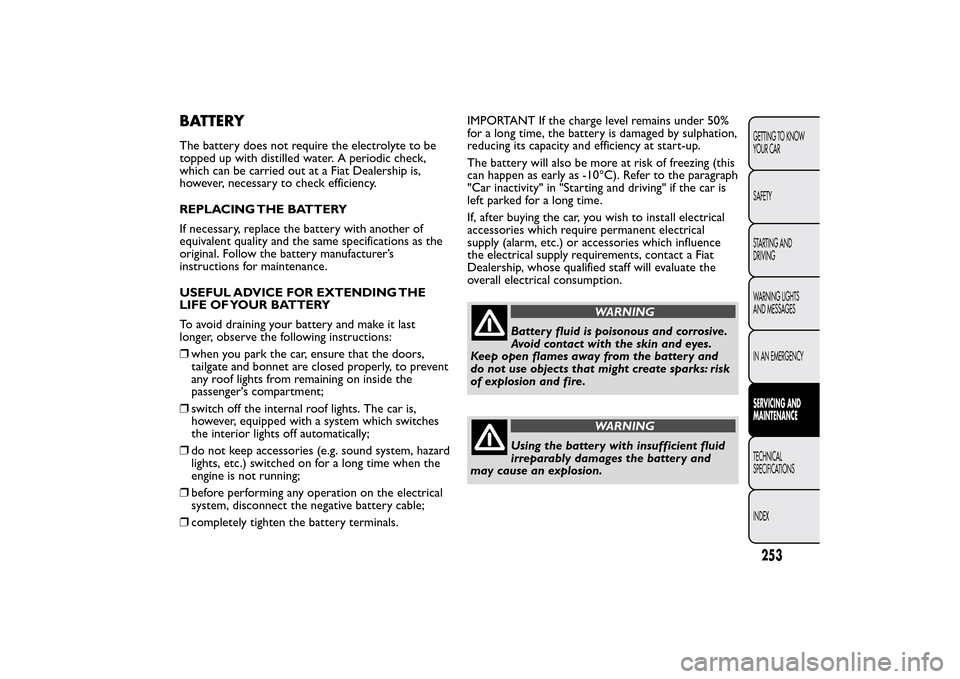
BATTERYThe battery does not require the electrolyte to be
topped up with distilled water. A periodic check,
which can be carried out at a Fiat Dealership is,
however, necessary to check efficiency.
REPLACING THE BATTERY
If necessary, replace the battery with another of
equivalent quality and the same specifications as the
original. Follow the battery manufacturer’s
instructions for maintenance.
USEFUL ADVICE FOR EXTENDING THE
LIFE OF YOUR BATTERY
To avoid draining your battery and make it last
longer, observe the following instructions:
❒when you park the car, ensure that the doors,
tailgate and bonnet are closed properly, to prevent
any roof lights from remaining on inside the
passenger's compartment;
❒switch off the internal roof lights. The car is,
however, equipped with a system which switches
the interior lights off automatically;
❒do not keep accessories (e.g. sound system, hazard
lights, etc.) switched on for a long time when the
engine is not running;
❒before performing any operation on the electrical
system, disconnect the negative battery cable;
❒completely tighten the battery terminals.IMPORTANT If the charge level remains under 50%
for a long time, the battery is damaged by sulphation,
reducing its capacity and efficiency at start-up.
The battery will also be more at risk of freezing (this
can happen as early as -10°C). Refer to the paragraph
"Car inactivity" in "Starting and driving" if the car is
left parked for a long time.
If, after buying the car, you wish to install electrical
accessories which require permanent electrical
supply (alarm, etc.) or accessories which influence
the electrical supply requirements, contact a Fiat
Dealership, whose qualified staff will evaluate the
overall electrical consumption.
WARNING
Battery fluid is poisonous and corrosive.
Avoid contact with the skin and eyes.
Keep open flames away from the battery and
do not use objects that might create sparks: risk
of explosion and fire.
WARNING
Using the battery with insufficient fluid
irreparably damages the battery and
may cause an explosion.
253GETTING TO KNOW
YOUR CAR
SAFETY
STARTING AND
DRIVING
WARNING LIGHTS
AND MESSAGES
IN AN EMERGENCYSERVICING AND
MAINTENANCETECHNICAL
SPECIFICATIONS
INDEX
Page 258 of 420
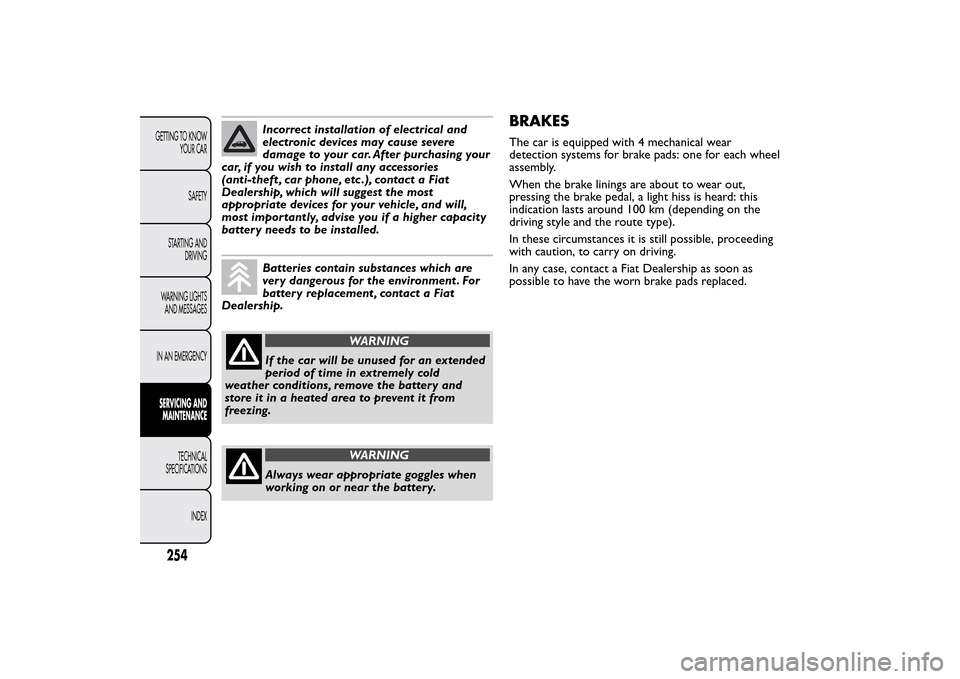
Incorrect installation of electrical and
electronic devices may cause severe
damage to your car. After purchasing your
car, if you wish to install any accessories
(anti-theft , car phone, etc .), contact a Fiat
Dealership, which will suggest the most
appropriate devices for your vehicle, and will,
most importantly, advise you if a higher capacity
battery needs to be installed.Batteries contain substances which are
very dangerous for the environment . For
battery replacement , contact a Fiat
Dealership.
WARNING
If the car will be unused for an extended
period of time in extremely cold
weather conditions, remove the battery and
store it in a heated area to prevent it from
freezing.
WARNING
Always wear appropriate goggles when
working on or near the battery.
BRAKESThe car is equipped with 4 mechanical wear
detection systems for brake pads: one for each wheel
assembly.
When the brake linings are about to wear out,
pressing the brake pedal, a light hiss is heard: this
indication lasts around 100 km (depending on the
driving style and the route type).
In these circumstances it is still possible, proceeding
with caution, to carry on driving.
In any case, contact a Fiat Dealership as soon as
possible to have the worn brake pads replaced.
254GETTING TO KNOW
YOUR CAR
SAFETY
STARTING AND
DRIVING
WARNING LIGHTS
AND MESSAGES
IN AN EMERGENCYSERVICING AND
MAINTENANCE
TECHNICAL
SPECIFICATIONS
INDEX
Page 259 of 420
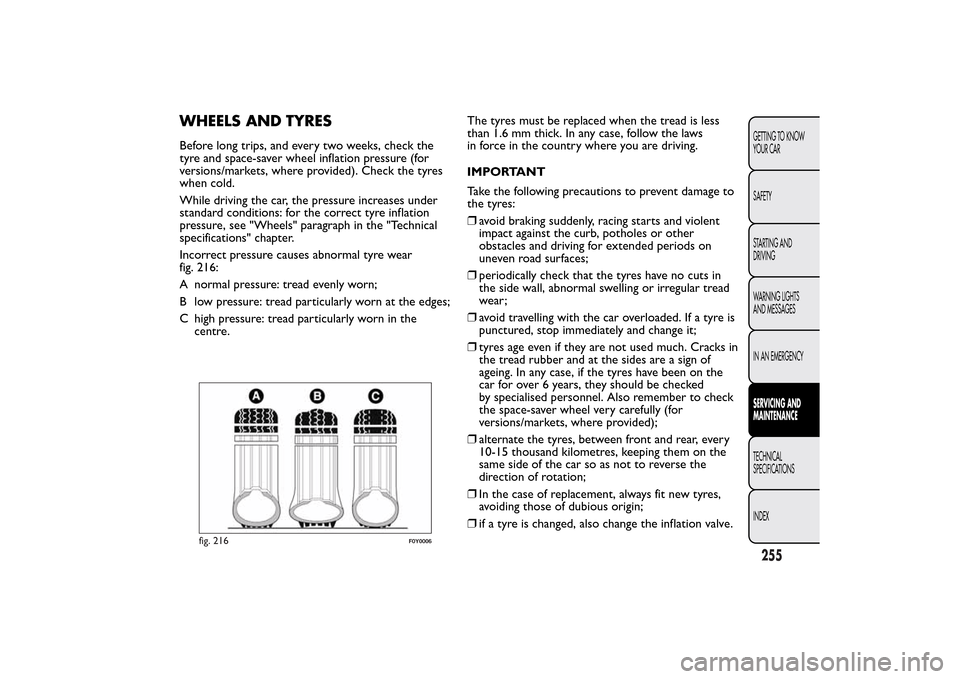
WHEELS AND TYRESBefore long trips, and every two weeks, check the
tyre and space-saver wheel inflation pressure (for
versions/markets, where provided). Check the tyres
when cold.
While driving the car, the pressure increases under
standard conditions: for the correct tyre inflation
pressure, see "Wheels" paragraph in the "Technical
specifications" chapter.
Incorrect pressure causes abnormal tyre wear
fig. 216:
A normal pressure: tread evenly worn;
B low pressure: tread particularly worn at the edges;
C high pressure: tread particularly worn in the
centre.The tyres must be replaced when the tread is less
than 1.6 mm thick. In any case, follow the laws
in force in the country where you are driving.
IMPORTANT
Take the following precautions to prevent damage to
the tyres:
❒avoid braking suddenly, racing starts and violent
impact against the curb, potholes or other
obstacles and driving for extended periods on
uneven road surfaces;
❒periodically check that the tyres have no cuts in
the side wall, abnormal swelling or irregular tread
wear;
❒avoid travelling with the car overloaded. If a tyre is
punctured, stop immediately and change it;
❒tyres age even if they are not used much. Cracks in
the tread rubber and at the sides are a sign of
ageing. In any case, if the tyres have been on the
car for over 6 years, they should be checked
by specialised personnel. Also remember to check
the space-saver wheel very carefully (for
versions/markets, where provided);
❒alternate the tyres, between front and rear, every
10-15 thousand kilometres, keeping them on the
same side of the car so as not to reverse the
direction of rotation;
❒In the case of replacement, always fit new tyres,
avoiding those of dubious origin;
❒if a tyre is changed, also change the inflation valve.
fig. 216
F0Y0006
255GETTING TO KNOW
YOUR CAR
SAFETY
STARTING AND
DRIVING
WARNING LIGHTS
AND MESSAGES
IN AN EMERGENCYSERVICING AND
MAINTENANCETECHNICAL
SPECIFICATIONS
INDEX
Page 260 of 420
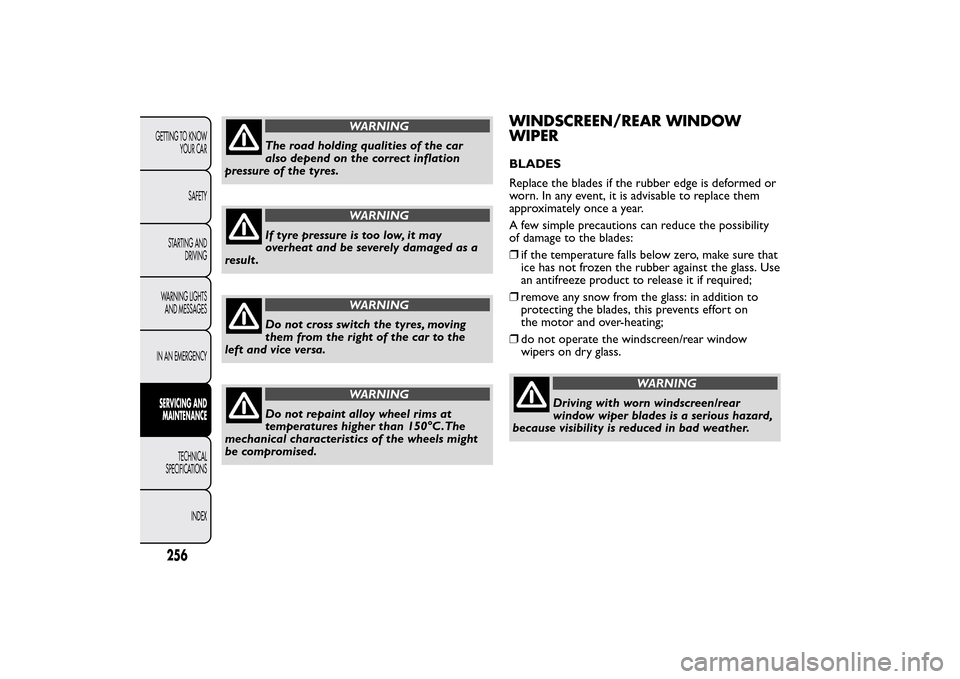
WARNING
The road holding qualities of the car
also depend on the correct inflation
pressure of the tyres.
WARNING
If tyre pressure is too low, it may
overheat and be severely damaged as a
result .
WARNING
Do not cross switch the tyres, moving
them from the right of the car to the
left and vice versa.
WARNING
Do not repaint alloy wheel rims at
temperatures higher than 150°C.The
mechanical characteristics of the wheels might
be compromised.
WINDSCREEN/REAR WINDOW
WIPERBLADES
Replace the blades if the rubber edge is deformed or
worn. In any event, it is advisable to replace them
approximately once a year.
A few simple precautions can reduce the possibility
of damage to the blades:
❒if the temperature falls below zero, make sure that
ice has not frozen the rubber against the glass. Use
an antifreeze product to release it if required;
❒remove any snow from the glass: in addition to
protecting the blades, this prevents effort on
the motor and over-heating;
❒do not operate the windscreen/rear window
wipers on dry glass.
WARNING
Driving with worn windscreen/rear
window wiper blades is a serious hazard,
because visibility is reduced in bad weather.
256GETTING TO KNOW
YOUR CAR
SAFETY
STARTING AND
DRIVING
WARNING LIGHTS
AND MESSAGES
IN AN EMERGENCYSERVICING AND
MAINTENANCE
TECHNICAL
SPECIFICATIONS
INDEX
Page 261 of 420

Lifting the wiper blades
If it is necessary to raise the blades from the
windscreen (e.g. in the event of snow or if the blades
need replacement) proceed as follows:
❒turn ring nut A fig. 217 in position
(windscreen
wiper off );
❒ignition key turned to the OFF position;
❒after turning the ignition key to STOP, move for at
least half a second the right lever in unstable
position within 2 minutes to activate the
windscreen wiper for a wiping section;
❒the previous operation can be repeated for a
maximum of 3 times in order to move the blades
in the most convenient position for their possible
replacement;
❒to lower the blades again turn the key to
MAR-ON.IMPORTANT Place the blades back in contact with
the windscreen before activating the windscreen
wiper again and/or turning the ignition key to
MAR-ON.
Replacing the windscreen wiper blades
Proceed as follows:
❒raise the wiper arm, press tab A fig. 218 of the
attachment spring and remove the blade from
the arm;
❒fit the new blade, inserting the tab into the special
slot in the arm, making sure that it is locked.
❒lower the windscreen wiper arm on the
windscreen.
Do not operate the windscreen wiper with
the blades lifted from the windscreen.
fig. 217
F0Y0049
fig. 218
F0Y0114
257GETTING TO KNOW
YOUR CAR
SAFETY
STARTING AND
DRIVING
WARNING LIGHTS
AND MESSAGES
IN AN EMERGENCYSERVICING AND
MAINTENANCETECHNICAL
SPECIFICATIONS
INDEX
Page 262 of 420
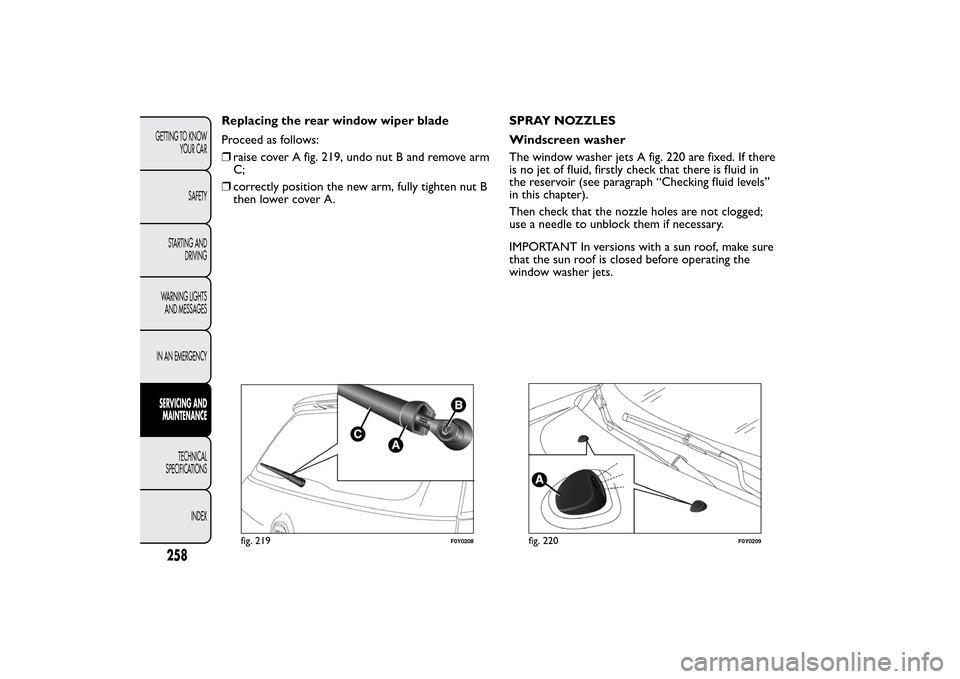
Replacing the rear window wiper blade
Proceed as follows:
❒raise cover A fig. 219, undo nut B and remove arm
C;
❒correctly position the new arm, fully tighten nut B
then lower cover A.SPRAY NOZZLES
Windscreen washer
The window washer jets A fig. 220 are fixed. If there
is no jet of fluid, firstly check that there is fluid in
the reservoir (see paragraph “Checking fluid levels”
in this chapter).
Then check that the nozzle holes are not clogged;
use a needle to unblock them if necessary.
IMPORTANT In versions with a sun roof, make sure
that the sun roof is closed before operating the
window washer jets.
fig. 219
F0Y0208
fig. 220
F0Y0209
258GETTING TO KNOW
YOUR CAR
SAFETY
STARTING AND
DRIVING
WARNING LIGHTS
AND MESSAGES
IN AN EMERGENCYSERVICING AND
MAINTENANCE
TECHNICAL
SPECIFICATIONS
INDEX